
12 minute read
Community Service
Despite having to navigate the ever changing COVID restrictions, our Community Service Committee still managed to raise both funds and awareness for many initiatives this semester.
Kaytlyn Johnson, Sophia Finnegan, Emma Wong and Lani Mott
Advertisement
Striving to make a tangible community impact
A highlight included the OakTree Live Below the Line challenge, where students lived on $2 a day for five days. By living on the Australian equivalent of the extreme poverty line, UC students developed an understanding of the lack of choice and opportunity faced by people living on so little. We had 45 participants and raised almost $4,000 in donations thanks to the hard work of the kitchen staff as well as the dedication and commitment of our students.
One Girl’s Do it in a Dress is one of UC’s most anticipated annual initiatives. Students wear school dresses for a week in order to raise funds for education programs in Sierra Leone and Uganda. This year we had over 80 sign ups and raised close to $20,000, ranking third on the team leaderboard and raising awareness by wearing the dresses in public. Throughout the semester we had more blood donations to the Australian Red Cross, with the total donations for the year reaching 71. This meant UC students donated their time and blood to save over 200 lives – an amazing effort and one of the highest numbers of donations by a University of Melbourne college this year. Additional events UC students were encouraged to take part in included the 40 Hour Famine, where students gave up a group of items such as food or furniture to raise funds for world poverty, purchasing UNICEF gift packs as presents, donating to op shops and purchasing sustainably through brands such as Thankyou. By taking part in community service initiatives, UC students have learnt transferable skills and knowledge while making tangible impact. Pip Smith Community Service Representative 2nd Year Commerce Student University of Melbourne
Growing from strength to strength
During the lockdowns, the stunning gardens and courtyards around UC have provided a welcome respite for our staff and students and have been integral to student wellbeing.
With the UC Redevelopment Project now completed, our gardening team have been able to turn their attentions to our outdoor spaces with renewed vigour. Alongside our head gardener, Ian, we now have both Ardi and Harri on board part time to ensure the garden continues to thrive. The knowledge of this incredible team has meant a number of new garden projects are underway.
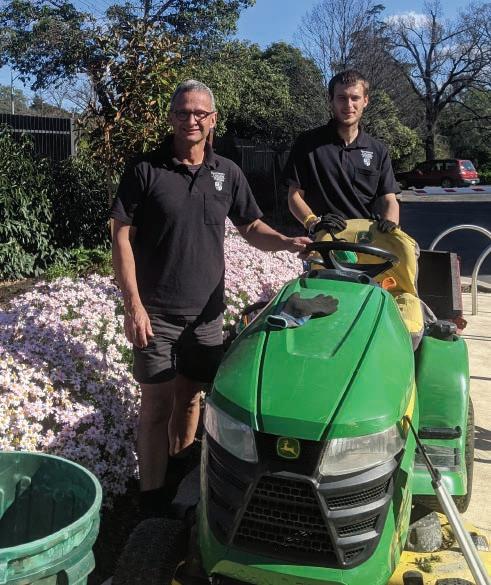
Ian Robertson and Ardi Strybosch
Fig Tree Garden – A tribute to Lorrie Lawrence (1938-2010)
We are in the process of establishing the Fig Tree Garden, which holds a special place in UC’s heart as many of the plants are in honour of the late Lorrie Lawrence (UWC 1957). Lorrie contributed greatly to the College, and specifically the garden. During Heather Hewitt’s leadership, Lorrie assisted in the design of many garden beds. She also conducted tours and lectures of private gardens, donating the funds raised to the College. In memory of her contributions, the Fig Tree Garden will be planted with some of her favourite plants. These include Camellia ‘Waterlily’, spring bulbs and a Wisteria grown on the pergola at the pedestrian gate on Cemetery Road West. A plaque will also be erected in her memory. We thank the late Lorrie Lawrence for her invaluable contributions.
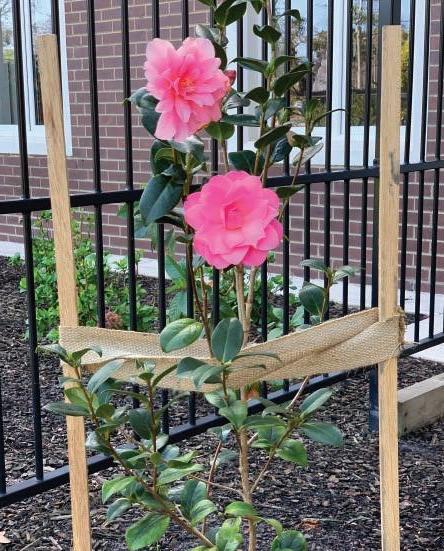
A favourite Camellia of Lorrie Lawrence
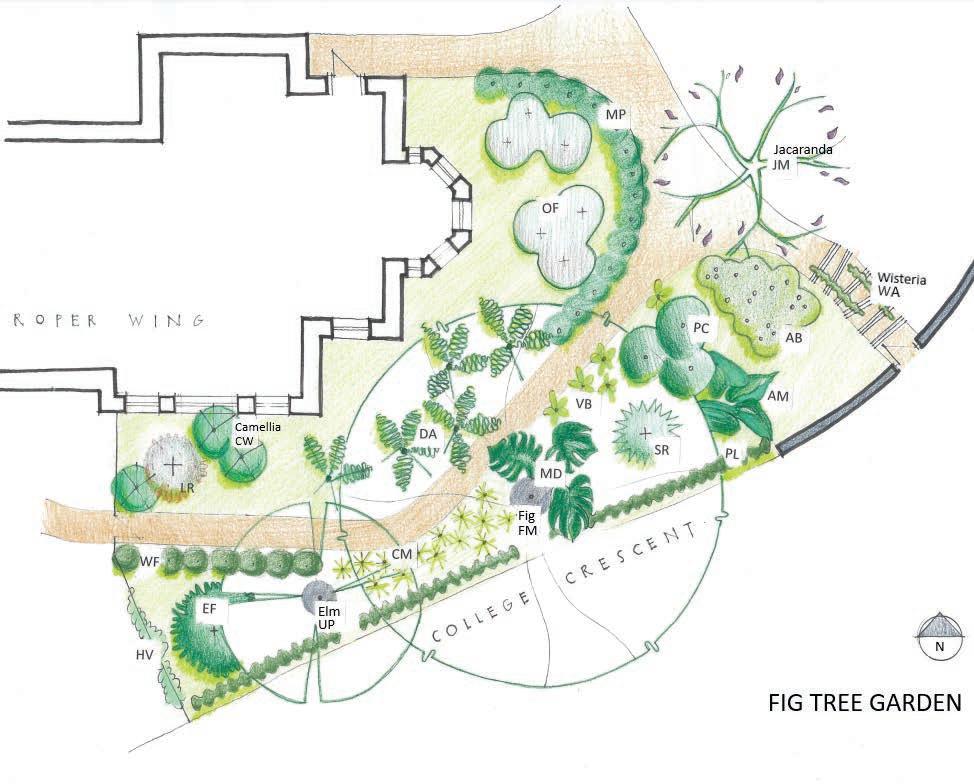
HV Hardenbergia violaea Happy Wanderer WF Waterhousea floribunda Weeping Lilly Pilly CW Camellia x williamsii ‘waterlily’ Camellia LR Loropetalum rubrum ‘china pink’ Chinese Fringe Flower EF Echium fastuosum Pride of Madeira PL Prunus lusitanica Portuguese Laurel UP Ulmus procera English Elm FM Ficus macrophylla Moreton Bay Fig CM Clivia miniata yellow Kaffir Lily DA Dicksonia antarctica Soft Tree Fern MD Monstera delisiosa Fruit Salad Plant SR Solanum rantonnetii Blue Potato Bush VB Velthemia bracteata Forest Lily PC Philadelphus coronarius Mock Orange AM Alocasia macrorrhiza Giant Taro MP Murraya paniculata Orange Jessamine OF Osteospermum fruiticosum African Daisy JM Jacaranda mimosifolia Jacaranda WA Wisteria floribunda ‘alba’ Japanese Wisteria – white AB Assorted Bulbs Daffodils, Blue Bells, Grape Hyacinths, Freesia
German engineering
Like the Passivhaus design of our new buildings, our garden is also taking inspiration from Germany in the form of our new Hugelkultur garden beds.
Hugelkultur is a technique of creating garden beds using waste that would otherwise go to landfill, meaning our gardeners can now dispose of garden waste onsite. This, in turn, prevents methane (greenhouse gas around 20 times more potent than carbon dioxide) being released into the atmosphere. This system also prevents weeds spreading during transport. The practice was first written about in 1962 by German gardener Herrman Andra, but has been utilised for hundreds of years in Eastern European societies. In English, Hugelkultur means ‘mound culture’ or ‘hill culture’. A Hugelkultur bed is typically constructed as a raised mound on a flat surface, but this can be modified for a slope, like at CERES Community Environment Park, where our gardener Ardi volunteers. To construct on a slope, you must first build a barricade out of dead branches. Then add thick branches or logs, weeds and other plant materials, a small amount of compost to kickstart the decomposition process and a layer of soil on top. The wood is essential to help aerate the soil and acts like a sponge to store water. It also provides nutrients during its gradual decay and sequesters carbon into the soil. The beds can then be simply left to decompose for up to 20 years.
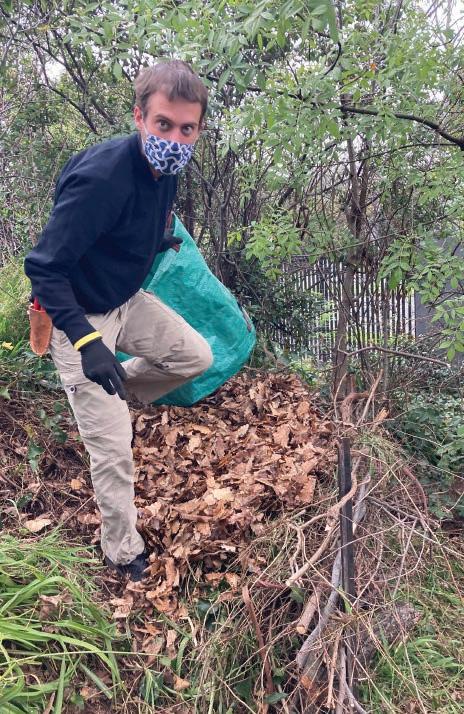
Ardi Strybosch
Elsewhere around the garden…
As students departed over the mid-semester break they were encouraged to leave their plants with gardener Ian so he could care for them in their absence. Turns out our students love plants – and Ian was responsible for many, many pots! Luckily he has a green thumb. In late October our student Sustainability Representative, Alex Brodie, organised a group of students to help plant the summer harvest. Thanks to everyone who volunteered.
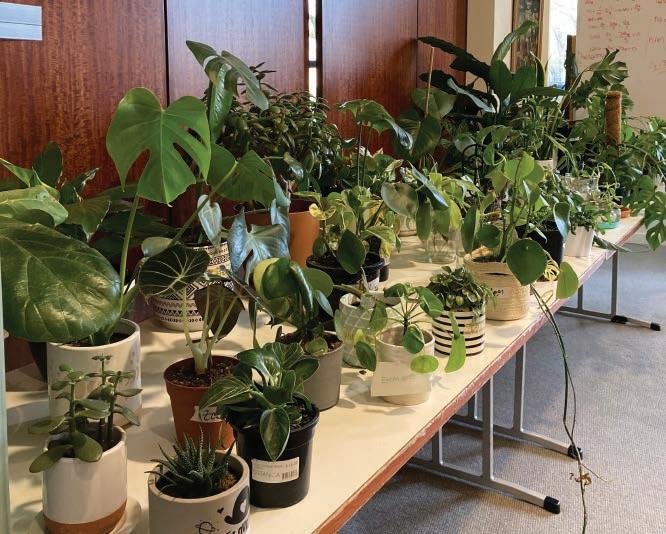
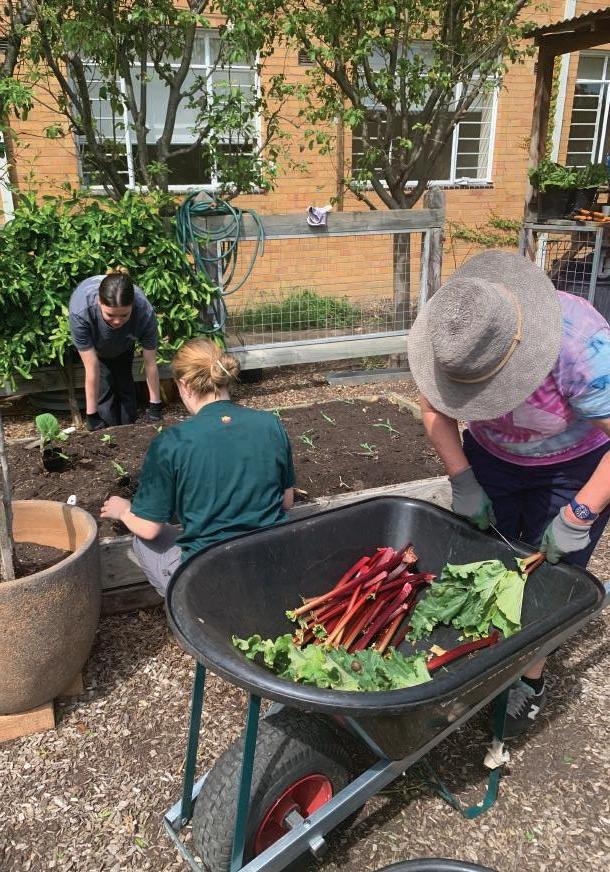
Celebrating Aussie natives
A native food garden has been established near our kitchen. First Nations people have farmed sustainably for thousands of years, and by studying their traditional practices, we can grow edible food that is both good for people and the planet. Soon our kitchen will be preparing these delicious edible plants in dishes for our students. A selection of five plants are being grown in the garden:
Murnong (Microseris scapigera) – a vulnerable species used widely prior to colonisation. Murnong grows white tuberous roots, which are sweet and taste like coconut.
Native leek (Bulbine bulbosa) – a native leek that produces a sweet starchy corm (or fleshy, underground stem). Strawberry Gum (Eucalyptus olida) – this plant’s leaves are used like a herb and taste like a combination of strawberry and passionfruit. Lemon Myrtle (Backhousia citrodora) – this plant’s leaves can be used as a herb and have a wonderful citrus smell and flavour.
Finger Lime (Citrus australasica) – an amazing citrus fruit, with caviar-like pulp (pictured right).
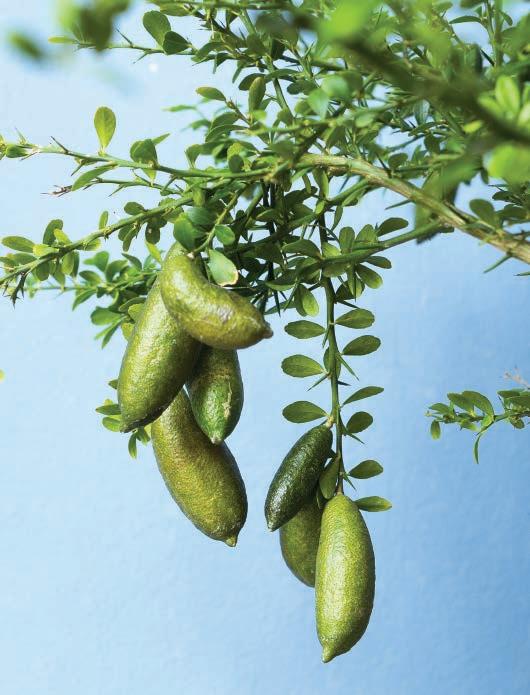
Plants
Planting new gardens such as the Fig Tree Garden creates more spaces for student wellbeing. Replanting the Kitchen Garden provides a summer harvest for the kitchen.
Soil health
Compost and mulch soil. This improves the soil structure, nutrients and microorganism activity.
The sustainable life cycle: Paddock to plate
Harvest
Vegetables, herbs and fruits are harvested from the Kitchen Garden, Herb Garden and Native Food Garden for the kitchen.
Compost
Food scraps from the kitchen are composted. Garden waste is either composted, mulched or used in the Hugelkultur beds.
Kitchen
Kitchen staff expertly prepare the harvested food for the students’ plates.
From paddock to plate
Food has been another staple for our students during lockdown, and our kitchen team have been working with our gardeners to utilise fresh ingredients and improve our sustainability processes.
For sous chef, Hazel, it’s an essential part of modern day cooking. “It’s part of the industry; every place I’ve worked, we always try and practice sustainability. Here at UC, Ian our gardener, will just bring things to the kitchen and we will work out what we can create. Some of it goes straight to the protein bar, like the broccoli, but we turn the eggplants into eggplant parmigiana and the rhubarb into strudel – it’s lots of fun and stimulates our creativity. We’re looking forward to the native herb garden being ready, so we can craft some Aussie dishes with that. A few of the chefs here have experience with those plants. And it’s not mass produced, so it has a lot of flavour.” With a herb garden right outside the kitchen door, staff can also grab whatever they need throughout the day. A new composting system was established last year, and although COVID restrictions have limited student accessibility to the kitchen, our kitchen staff have still been utilising this throughout the pandemic. “Not being able to have face-to-face interaction with the students during lockdowns and seeing how they reacted to our food was tough – because technically they are my regulars, so usually I would have a feel for what they like and can anticipate their needs. So I can’t wait till the kitchen opens up again,” said Hazel. Our Executive Chef, Philip, added the team also has lots of ideas for future initiatives in this space. “We are already looking to expand the kitchen garden and hopefully get staff more directly involved in the student sustainability committee, so we can work together on this concept. Chickens, bees and lots of other ideas may be possible as well in the future. Our kitchen team is very keen to develop this paddock to plate concept, or garden to gut, as I like to call it! Whatever phrase you use, we are totally up for working with the students and the garden team to expand our initiatives in 2022 and beyond.”
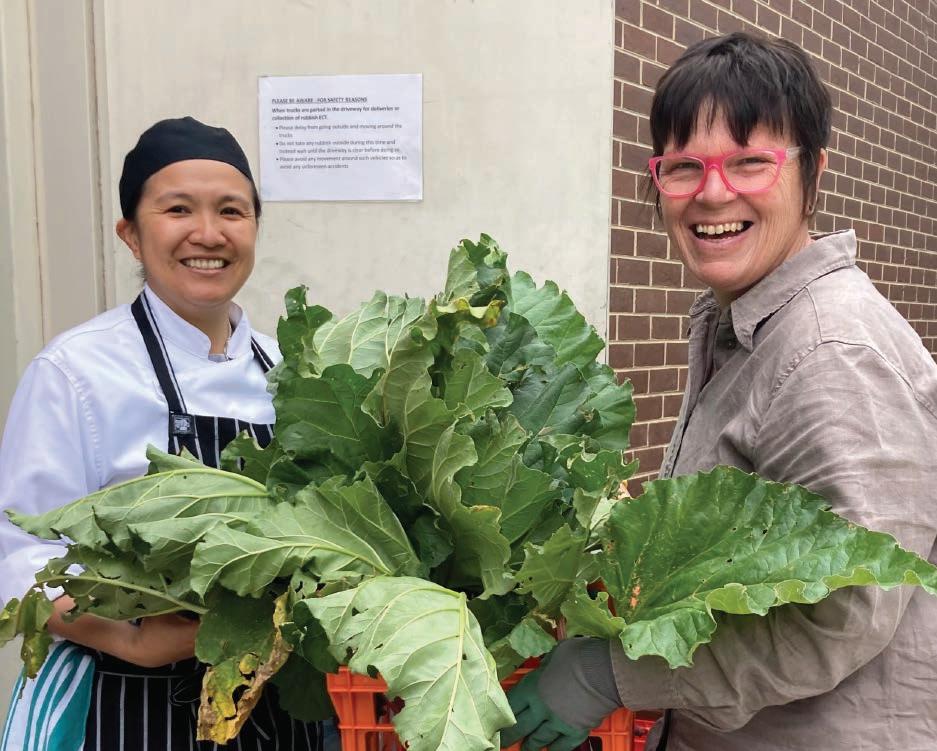
Sous Chef Hazel Krauss receiving some Kitchen Garden bounty from Harry Sulikowski
Award-winning apprentice
Jahvaan Quilter is an apprentice chef in the UC kitchen, and she recently won the Best Cookery (Apprentice) Student of the Year award from Melbourne Polytechnic.
“My dedication to finishing my apprenticeship during the pandemic caught the eye of one of my TAFE teachers, and he nominated me. To be honest I didn’t think I was going to win it, but I did! It was a surreal feeling, I’ve never won anything this big before,” she said. Jahvaan is also informally known as UC’s Dessert Queen. “I do have a passion for desserts. I love making anything sweet that makes people happy. My favourite is brownies and cold-set cheesecakes, because you can play around with flavours and it’s the dessert my mum loves. Simple yet tasty.” “I enjoy working at UC because everyone is friendly and I get to experiment in the kitchen. But I never imagined I’d be called Queen of Desserts. After that compliment who wouldn’t want to work here!” In the near future Jahvaan plans to undertake a patisserie course to become a pastry chef. Congratulations Jahvaan – we love having you on the staff team at UC.
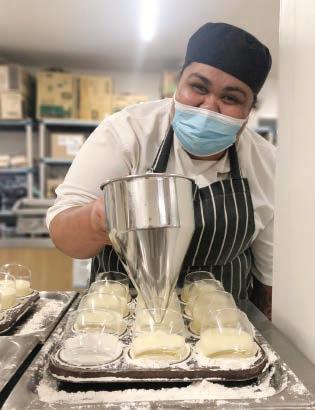
Journey around the world
We may have been in lockdown for the majority of Semester 2, but our talented kitchen crew took our taste buds on a journey around the world through weekly themed dinners.
The theme for each week was chosen during a kitchen-wide brainstorming session, which also looked at popular food trends and cuisines that the chefs most enjoyed creating. Special consideration was also given to the suitability of each dish to be served as part of a buffet-style meal. Executive Chef, Philip Garrod, shares that the chefs took pleasure in making these themed dinners because “it was a break from the normal, something new we could challenge ourselves with and an opportunity to explore new dishes.” Themes have included: • Aussie BBQ • Mexican • Middle Eastern • South Pacific • Spanish • Sri Lankan • British • French • German • Indian • Italian • Japanese • Mauritius
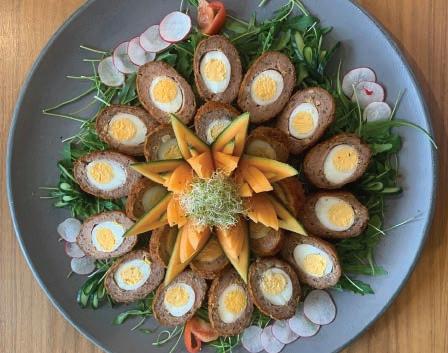
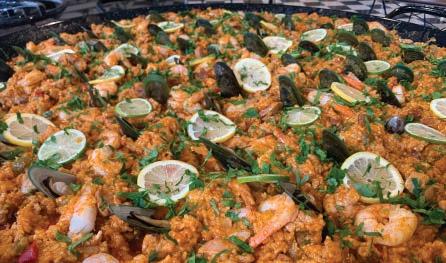
French dinner menu
Thursday 27 May
Soup French onion soup, gruyere cheese croutons
Salads Salad nicoise with tuna Du puy lentil salad French butter lettuce salad
Mains ‘Coq au vin” (chicken in red wine, shallots) “Blanquette de veau” (veal in cream sauce, mushroom) “Moules mariniere” (mussel in white wine) “Ratatouille” (assorted vegetable stew) “Patate dauphinoise” (gratin potato)
Sides Pommery mustard Cornichon Tomato relish
Dessert Cheese board consisting of roquefort, camembert and cheddar, stoned dried fruits, lavosh and crackers
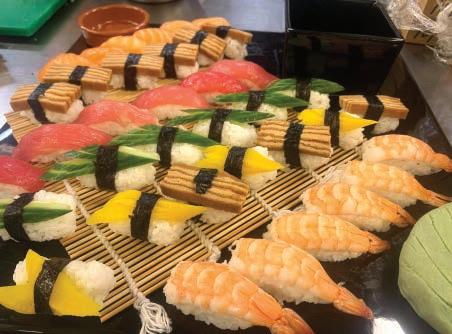
Japanese dinner menu
Thursday 23 September
Appetizer Tokyo selection of maki sushi, nigiri sushi, Philadelphia roll
Salads “Sunomono” (Japanese cucumber salad) “Wakame” (seaweed salad) Cabbage salad with “wafu” dressing
Mains “Japanese pork “katsu” curry (panko crumbed pork) Chicken “yakitori” (skewers) “Yaki udon” (stir fry noodles with beef) “Vegetable “katsu” curry (assorted crumbed vegetables with curry sauce) Vegetarian “okonomiyaki” (vegetable pancake) “Agedashi” tofu (fried tofu) Pan fried vegetable gyoza Condiments: Akari soy sauce, wasabi, pickled ginger, bonito flakes, furikake
Dessert “Matcha panna cotta” (green tea creamy pudding)
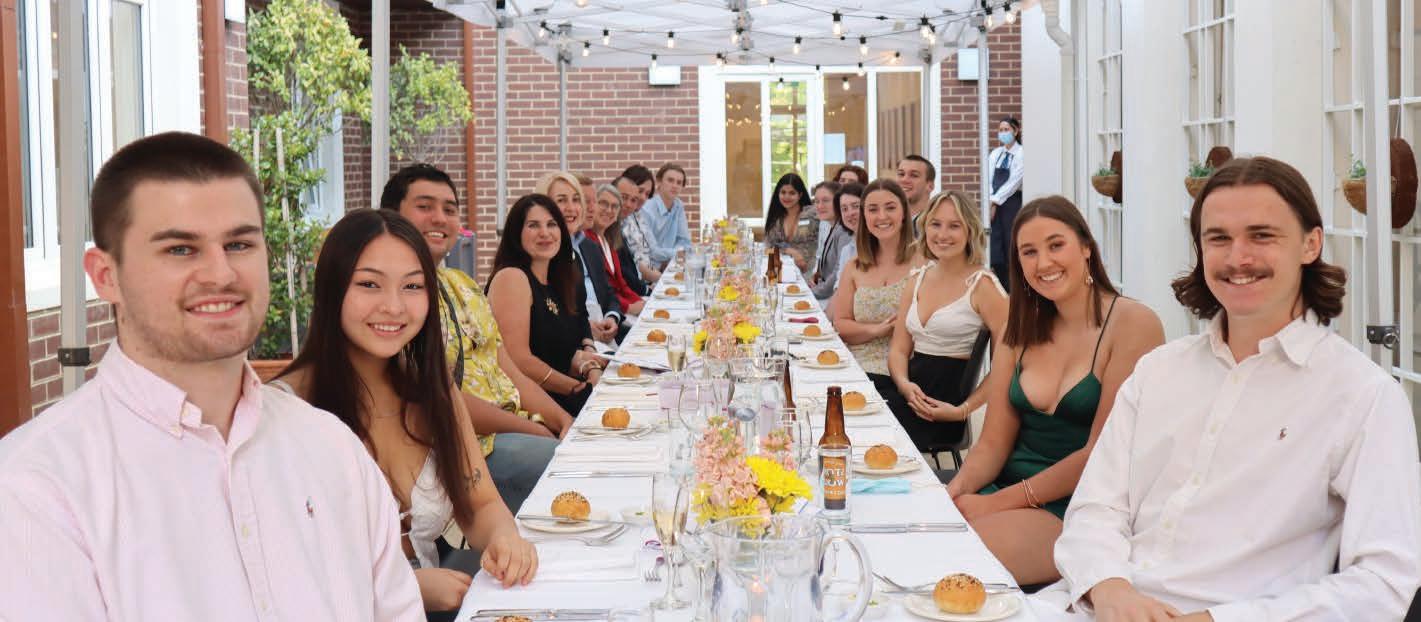
Stakeholders Dinner
Final farewells
When restrictions finally eased at the end of October, there was just enough time to hold some farewell dinners for our students. Over a series of evenings, small friendship groups were able to enjoy a high table-style three course menu in an alfresco setting – just like the dinners we held at the start of the year. Our kitchen team were thrilled to be able to get back to creating dishes for these events.
The series kicked off with a stakeholders dinner, where senior staff members dined with our student leadership team and thanked them for their service to the College. Thank you everyone for pulling together these dinners at short notice – they were thoroughly enjoyed by all.
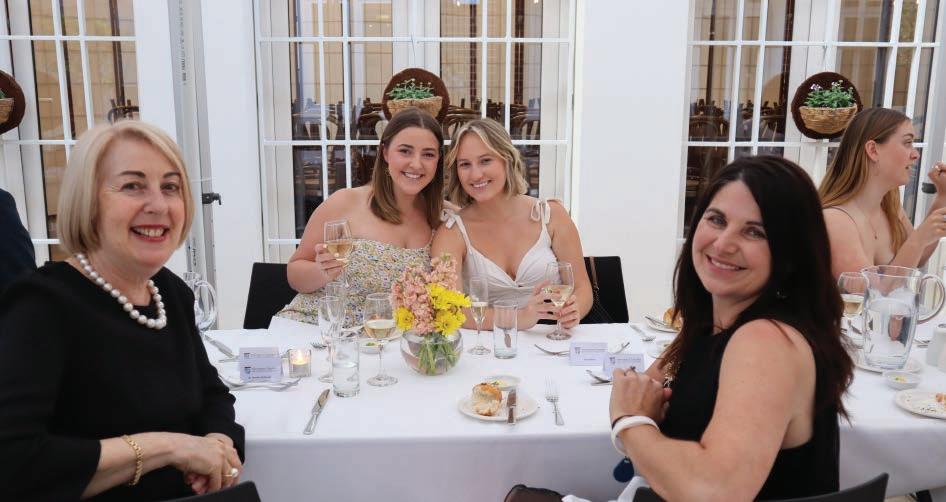
Dr Jennifer McDonald, Rachael McDonald, Taila White and Liz Agostino

Pip Kennett and Claudia Lee









